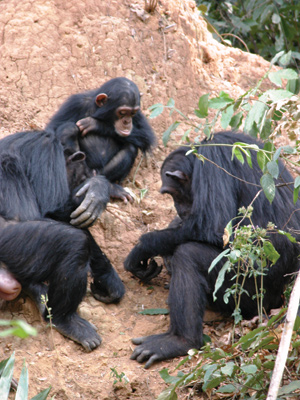|
||
      |
Citations
Collision course
When the burned-out core of a dead star—called a neutron star—succumbs to gravity and slips into a black hole, the collision creates a split-second explosion so powerful it lights up one-thirtieth of the universe, releasing 100 thousand trillion times more energy than the sun, according to a report in the October 6 Nature that answers long-standing questions about the origin of short gamma-ray bursts. Coauthored by Don Lamb, the Louis Block professor of astronomy & astrophysics, the study used three NASA satellites and numerous ground-based telescopes to determine that the bursts emanate either from two colliding neutron stars or from a neutron star sucked into a black hole.

For Tanzanian chimps, termite-fishing is a left-handed job.
Trend sinister
It’s a right-handed world, no question—for humans. But for chimpanzees fishing termites out of the ground with a stick, the left hand rules. Looking for evidence of population-level handedness in apes—akin to humans’ bias toward the right hand—University primatologist Elizabeth V. Lonsdorf and scientists at the Yerkes National Primate Research Center in Atlanta followed wild chimps through Tanzania’s Gombe National Park. They discovered that the animals favored the left hand two-to-one for the precise motions of termite-fishing. The researchers also found evidence that chimpanzee southpaws might inherit their predisposition. Those results, published in the August 30 Proceedings of the National Academy of Sciences, belie earlier arguments that primate handedness is more random than systematic.
Evolution of thought
Humans may have surrounded themselves with cars, computers, and cell phones, but they aren’t yet beyond the reach of natural selection, says Chicago geneticist Bruce Lahn. In a study published in the September 9 Science, Lahn and fellow U of C researchers argue that adaptive pressures are behind the spread of two gene mutations that increase the size and cognitive ability of the human brain. The changes are swift by evolutionary standards: one of the new genes likely surfaced only 37,000 years ago, and the other as recently as 5,800 years ago, about the time the written word was making its Mesopotamian debut.
Ozone stands its ground
Researchers at the University’s Center for Integrating Statistical and Environmental Science are breathing a little easier these days, having determined that the ozone layer is no longer receding. In some parts of the world it has even inched forward slightly, although ozone levels are still nowhere near the standard thickness of 300 to 500 Dobson units, and full recovery is decades away. Scientists calculated changes in the ozone layer using data from satellites and ground stations. Coauthored by Betsy Weatherhead, AB’85, SM’92, PhD’93, a University of Colorado researcher, the report appeared in the August 31 Journal of Geophysical Research.
Size up the risk
After coronary-bypass surgery, women are nearly twice as likely as men to die from complications. Yet it is difficult to pin down all the reasons why, according to a study led by Hospitals cardiology fellow Ron Blankstein. Partly to blame are the usual suspects—age, diabetes, advanced heart failure—which show up at higher rates in female bypass patients. Blankstein also found that body size plays a role. But his research, published in the annual cardiovascular surgery supplement of Circulation, indicates that merely being female may also be a risk factor: even accounting for other variables, women are still 22 percent more likely to die than men.